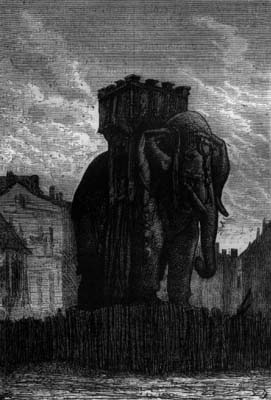units
image banks
--l'assiette au beurre
--Les Quatre Saisons de la Kultur

TALLEYRAND AND LAFAYETTE
In their own persons, Lafayette and Talleyrand embodied the split personality
of the French Revolution. For while it is commonplace to recognize that
the Revolution gave birth to a new kind of political world, it is less
often understood that that world was the product of two irreconcilable
interests—the creation of a potent state and the creation of a community
of free citizens. The fiction of the Revolution was to imagine that each
might be served without damaging the other and its history amounts to the
realization of that impossibility.
ELEPHANT
Between 1814 and 1846 a plaster elephant stood on the site of the Bastille.
For much of this time it presented a sorry spectacle. Pilgrims in search
of revolutionary inspiration were brought up short at the sight of it,
massive and lugubrious, at the southeast end of the square. By 1830, when
revolution revisited Paris, the elephant was in an advanced state of decomposition.
One tusk had dropped off, and the other was reduced to a powdery stump.
Its body was black from rain and soot and its eyes had sunk, beyond all
natural resemblance, into the furrows and pockmarks of its large, eroded
head.
This was not what Napoleon had intended. Concerned with obliterating
the revolutionary memory, he had first thought of siting a grand triumphal
arch on the empty space vacated by the demolished fortress. But eastern
Paris was unfashionable, and the decision was taken to move the arch to
the west of the city instead. Rummaging around in the fancies of antiquity,
Napoleon came up with another idea that would signify, just as decisively,
he believed, the superiority of imperial conquest over chaotic insurrection.